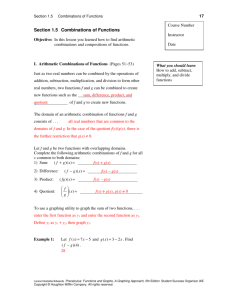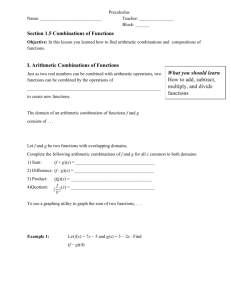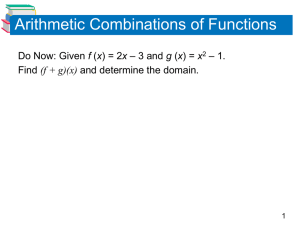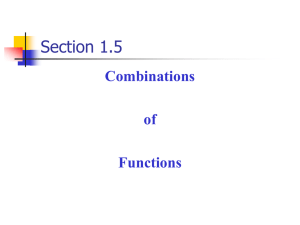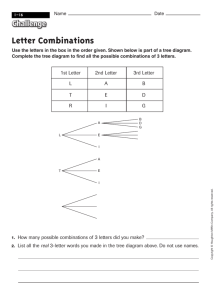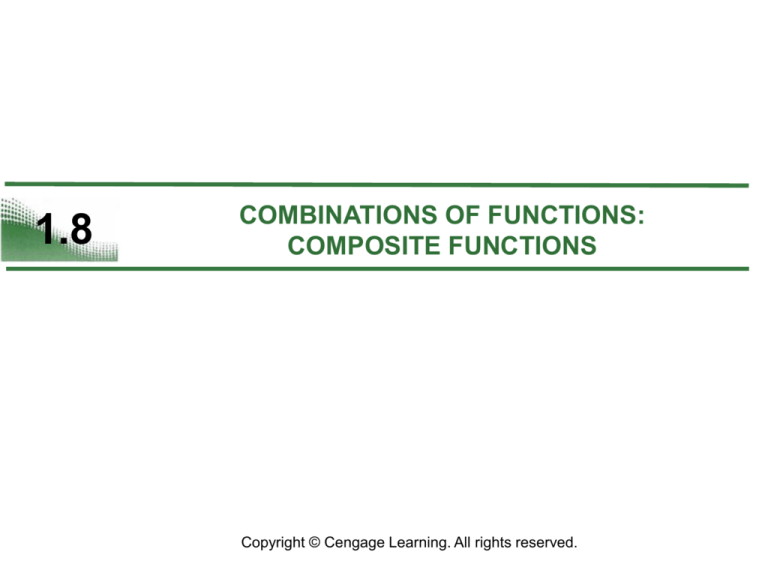
1.8
COMBINATIONS OF FUNCTIONS:
COMPOSITE FUNCTIONS
Copyright © Cengage Learning. All rights reserved.
What You Should Learn
• Add, subtract, multiply, and divide functions.
• Find the composition of one function with
another function.
• Use combinations and compositions of
functions to model and solve real-life problems.
2
Arithmetic Combinations of Functions
3
Arithmetic Combinations of Functions
Given: f (x)= 2x – 3 and g(x) = x2 – 1
f (x) + g(x) = (2x – 3) + (x2 – 1) = x2 + 2x – 4
Sum
f (x) – g(x) = (2x – 3) – (x2 – 1) = –x2 + 2x – 2
Difference
f (x)g(x) = (2x – 3)(x2 – 1) = 2x3 – 3x2 – 2x + 3
Product
Quotient
4
Arithmetic Combinations of Functions
The domain of an arithmetic combination of functions
f and g consists of all real numbers that are common to the
domains of f and g.
In the case of the quotient f (x)/g (x), there is the further
restriction that g (x) 0.
5
Arithmetic Combinations of Functions
6
Example 1 – Finding the Sum of Two Functions
Given f (x) = 2x + 1 and g(x) = x2 + 2x – 1 find (f + g)(x).
Then evaluate the sum when x = 3.
Solution:
(f + g)(x) = f (x) + g(x) = (2x + 1) + (x2 + 2x – 1)
= x2 + 4x
When x = 3, the value of this sum is
(f + g)(3) = 32 + 4(3)
= 21.
7
Composition of Functions
8
Composition of Functions
Given f(x) = x2 and g(x) = x + 1, the composition of f with g
is
f (g(x)) = f (x + 1)
= (x + 1)2.
This composition is denoted as f g
and reads as “f composed with g.”
9
Composition of Functions
Figure 1.90
10
Example 5 – Composition of Functions
Given f (x) = x + 2 and g(x) = 4 – x2, find the following.
a. (f g)(x) b. (g f )(x) c. (g f )(–2)
Solution:
a. The composition of f with g is as follows.
(f g)(x) = f(g(x))
Definition of f g
= f(4 – x2)
Definition of g (x)
= (4 – x2) + 2
Definition of f (x)
= –x2 + 6
Simplify.
11
Example 5 – Solution
cont’d
b. The composition of g with f is as follows.
(g f )(x) = g(f (x))
Definition of g f
= g(x + 2)
Definition of f(x)
= 4 – (x + 2)2
Definition of g(x)
= 4 – (x2 + 4x + 4)
Expand.
= –x2 – 4x
Simplify.
Note that, in this case, (f g)(x) (g f)(x).
12
Example 5 – Solution
cont’d
c. Using the result of part (b), you can write the following.
(g f )(–2) = –(–2)2 – 4(–2)
Substitute.
= –4 + 8
Simplify.
=4
Simplify.
13
Composition of Functions
Given h(x) = (3x – 5)3 is the composition of f with g where
f(x) = x3 and g(x) = 3x – 5.
h(x) = (3x – 5)3 = [g(x)]3 = f(g(x)).
14
Application
15
Example 8 – Bacteria Count
The number N of bacteria in a refrigerated food is given by
N(T ) = 20T 2 – 80T + 500,
2 T 14
where T is the temperature of the food in degrees Celsius.
When the food is removed from refrigeration, the
temperature of the food is given by
T(t) = 4t + 2, 0 t 3
where t is the time in hours.
(a) Find the composition N(T(t)) and interpret its meaning in
context.
(b) Find the time when the bacteria count reaches 2000.
16
Example 8(a) – Solution
N(T(t)) = 20(4t + 2)2 – 80(4t + 2) + 500
= 20(16t2 + 16t + 4) – 320t – 160 + 500
= 320t2 + 320t + 80 – 320t – 160 + 500
= 320t2 + 420
The composite function N(T(t)) represents the number of
bacteria in the food as a function of the amount of time the
food has been out of refrigeration.
17
Example 8(b) – Solution
cont’d
The bacteria count will reach 2000 when
320t 2 + 420 = 2000. Solve this equation to find that the
count will reach 2000 when t 2.2 hours.
When you solve this equation, note that the negative value
is rejected because it is not in the domain of the composite
function.
18








